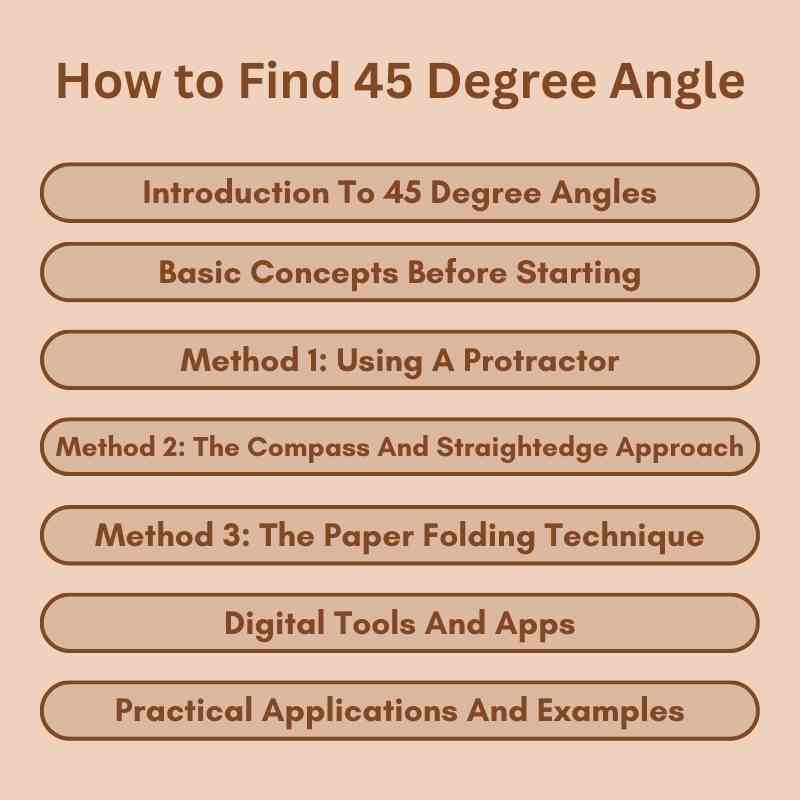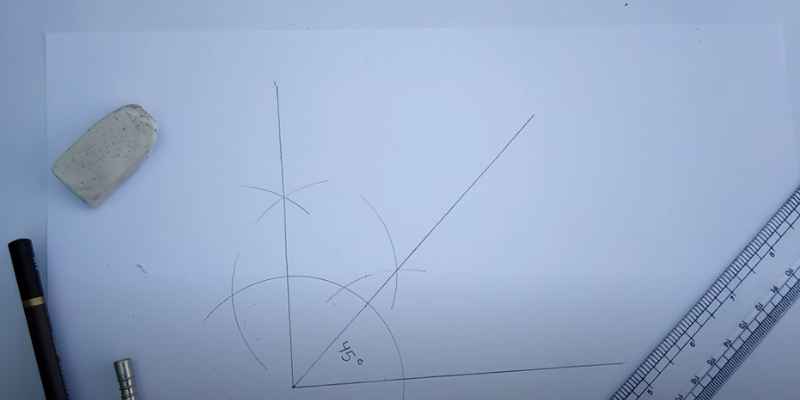To find a 45-degree angle, use a protractor to measure 45 degrees from a straight line. Alternatively, create a right-angled triangle with equal legs.
Understanding angles is fundamental in geometry and various practical applications. A 45-degree angle, known as a right angle, is pivotal in construction, design, and art. It allows for balance and symmetry, making it essential in various fields. Whether you’re drafting blueprints or crafting furniture, recognizing and creating a 45-degree angle can enhance precision.
This angle is often used in right-angled triangles, where it signifies equal leg lengths. Mastering how to identify and construct this angle will greatly benefit both novice learners and seasoned professionals. This guide will provide clear steps to effectively find a 45-degree angle with ease.
Introduction To 45 Degree Angles
Understanding the importance of 45-degree angles is crucial in both design and construction. They provide a strong structural base for various projects. Designers use them to create aesthetic appeal and ensure balance in their work.
Many challenges arise when working with 45-degree angles. Measuring accurately can be difficult. Using tools like a protractor or set square helps achieve precision. Misalignment can lead to costly mistakes. Proper planning and practice can overcome these hurdles.
Incorporating 45-degree angles enhances the functionality and visuals of any project. Mastering these angles is essential for anyone involved in construction or design.

Basic Concepts Before Starting
Understanding angles is essential before finding a 45-degree angle. An angle is formed where two lines meet at a point, known as the vertex. The size of an angle is measured in degrees. A 45-degree angle is half of a right angle, which is 90 degrees.
To measure angles accurately, certain tools are necessary. A protractor is the most common tool for measuring angles. It has a curved edge marked in degrees. A set square can also help in drawing and measuring right angles and 45-degree angles. Finally, a ruler is useful for drawing straight lines, which are essential in angle construction.
Method 1: Using A Protractor
To find a 45-degree angle using a protractor, follow this simple guide:
1. Place the protractor on the line where you want the angle. The center hole should be on the point where the angle will be.
2. Align the baseline of the protractor with one side of the angle.
3. Locate the 45-degree mark on the protractor. This is usually on the inner scale.
4. Draw a line from the center point to the 45-degree mark. This line represents the second side of the angle.
To ensure accuracy, keep these tips in mind:
- Use a sharp pencil for clear markings.
- Double-check the alignment before drawing.
- Hold the protractor steady while marking.
Method 2: The Compass And Straightedge Approach
To create a perfect semicircle, start by drawing a line segment BC of any length. Use point B as the center. Draw a semicircle that bisects line segment BC at point P. This semicircle will help in finding the 45-degree points. Next, mark the points where the arcs intersect the semicircle as X and Y. These points will serve as guides for your next steps.
After marking points X and Y, draw a line from point X to point B. Then, draw another line from point Y to point B. The angle formed between these two lines will be a 45-degree angle. This method is simple and effective for creating accurate angles.
Method 3: The Paper Folding Technique
To find a 45-degree angle using the paper folding technique, follow these simple steps:
- Start with a square piece of paper.
- Fold the paper diagonally to form a triangle.
- Ensure the corners align neatly to create a sharp crease.
- Unfold the paper to see the crease line.
- Next, fold one corner down to meet the crease.
- This new crease will mark a 45-degree angle.
This technique works because folding creates precise angles. Each fold divides the angle, ensuring accuracy.
Method 4: Employing A Speed Square
Using a speed square is a simple way to find a 45-degree angle. Start by placing the square on your material. Align one edge with the edge of your material. The other edge will show the 45-degree angle.
To mark the angle, use a pencil along the edge of the speed square. Lift the square away to see your marked line. Cut along this line for a perfect angle.
Advantages of this method include:
- Easy to use for beginners.
- Provides quick and accurate results.
- Compact and lightweight for easy transport.
- Works on different materials like wood and metal.
Digital Tools And Apps
Finding a 45-degree angle can be easily achieved using various digital tools and apps. These resources offer precise measurements and step-by-step instructions, making angle construction straightforward. Embrace technology to simplify your geometric tasks and enhance your design projects.
Recommended Apps
Several apps can help find a 45-degree angle easily. Popular choices include:
- Angle Meter – Measure angles with your device’s camera.
- Protractor – Simple interface for angle measurements.
- CAD Apps – Great for precise designs and angles.
How To Use Them Effectively
To use these apps effectively, follow these steps:
- Open the app and select the angle tool.
- Align your device with the angle you want to measure.
- Read the angle displayed on the screen.
- Use the draw feature for planning your projects.
Practical Applications And Examples
Woodworking often requires precise angles for strong joints. A 45-degree angle is common for making miter cuts. This angle helps create smooth corners in frames and furniture. Using a miter saw simplifies this process. Mark the cut line clearly for accuracy.
In architectural design, a 45-degree angle adds elegance to structures. This angle can enhance visual appeal in roofs and windows. It also supports better light flow inside a space. Architects often use software to visualize these angles effectively.
Troubleshooting Common Issues
Finding a 45-degree angle can sometimes lead to inaccuracies. Here are some common issues and solutions:
- Ensure the tools used are properly calibrated.
- Double-check measurements before marking.
- Use a protractor for precise angle measurement.
- Verify the alignment of your reference points.
Choosing the right method is essential for accuracy:
| Method | Best Used For |
|---|---|
| Protractor | Exact angle measurements |
| Triangle | Creating quick right angles |
| Compass and Straightedge | Geometric constructions |

Frequently Asked Questions
How To Find A 45 Degree Angle Without A Protractor?
To find a 45-degree angle without a protractor, use a compass. Draw a circle and mark the center. Draw a horizontal line through the center. Create an arc from the center to intersect the circle. Connect the intersection points to form a 45-degree angle.
How Can I Get A 45 Degree Angle?
To create a 45-degree angle, use a protractor for accuracy. Alternatively, draw a right triangle with equal legs. For construction, measure and mark 45 degrees using a framing square. A compass can also help by drawing arcs intersecting at 45 degrees.
How To Calculate A 45 Degree Cut?
To calculate a 45-degree cut, measure the desired length on your material. Use a protractor or square to mark the 45-degree angle. Cut along the marked line for an accurate angle. Always double-check your measurements before cutting to ensure precision.
How Do You Find The Slope Of A 45 Degree Angle?
To find the slope of a 45-degree angle, use the tangent function. The slope is equal to the tangent of 45 degrees, which is 1. This means for every unit rise, there is a unit run. Hence, the slope of a 45-degree angle is 1.
Conclusion
Finding a 45-degree angle can be straightforward with the right methods. Whether using a protractor or constructing it geometrically, these techniques are practical and effective. Mastering this skill opens doors to various applications in math and design. Embrace these strategies to enhance your geometry expertise and confidence.

